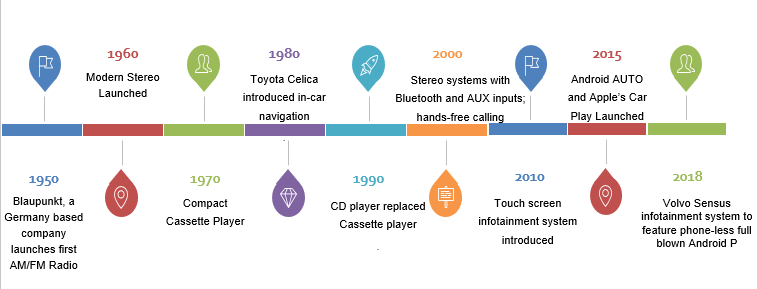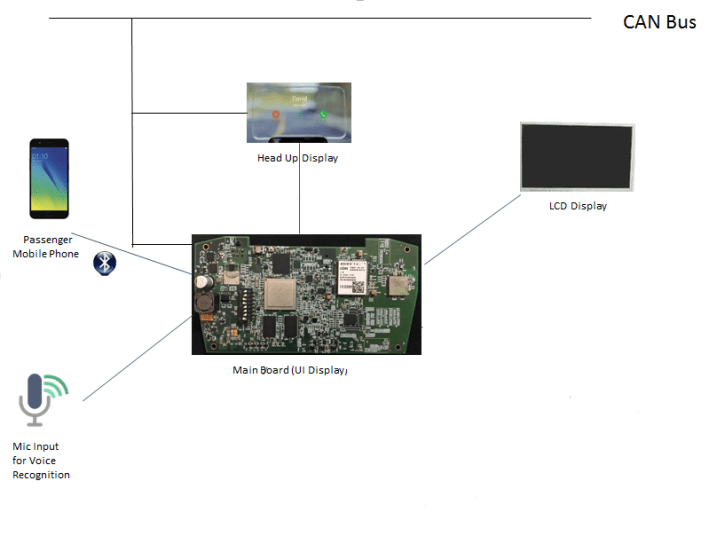While talking about the industries that have shown exceptional growth and fast-paced innovation, automotive industry definitely deserves a loud mention.
Not more than a decade ago, we never expected our cars to be a powerhouse of connectivity.
Thanks to the advancements in sensor technologies, robust in-vehicle networking, and smart automotive Electronic Control Units (ECUs), we are witnessing a new era of connected systems.
Information related to driver assistance, navigation, instrument cluster and access to phone calls/messaging are being delivered seamlessly to the driver.
All this data is delivered via different sources like CAN in-vehicle network, connected Sensors or through IP/GPS/Cloud connectivity
The need to display such critical data, provide ease of access and mitigate driver distraction led to the introduction of multi-display infotainment display. This is one system among the car’s components that has evolved very rapidly.
Let’s have a look at the story of evolution of Automotive Infotainment solutions over the years

Image: Evolution of Car Infotainment system
It all started with a modest FM radio on the dashboard and now the modern in-vehicle infotainment system is evolving into a seamless multi-display system.

Source: Carz2web and Lincoln/Continental
Introducing “Multi-display Infotainment Systems” for Cars!
The evolution of infotainment system in cars has now reached a point where one display does not suffice. The multi-display infotainment system has become the need of the hour.
Glimpse of the modern day vehicle cockpit
Most traditional infotainment consoles have been positioned at the center of the dashboard. Displaying information on this console needs constant attention of the driver away from the on-road viewing area. This has raised a concern regarding driver distraction.
- In order to mitigate this, car head-up display has been introduced. Car Heads-up Display (HUD) sits just in front of the driver on the dashboard within the on-road viewing area.
- Instrument Cluster can also be considered as one more display which helps driver to access critical vehicle data via CAN in-vehicle network.
Traditionally all these display systems (Infotainment, Head-Up Display, Instrument Cluster) work in silos. They are powered by separate Automotive Control Units (aka ECU), have independently designed UI/UX, fetch data from respective sources and are very likely to be developed by separate automotive suppliers.
Glimpse of the advanced Tesla-like vehicle cockpits
Welcome ‘Multi-display Infotainment system’, which is powered by a single Automotive ECU (single hardware) and has one central processing unit.
This central hardware & software system works as a hub that projects the output on multiple displays; viz; Car Head-up Display or Windshield, Digital Cluster, Connected Mobile phone and more.
How Does a Multi-Display Infotainment display system Work?
A typical multi-display infotainment system would essentially feature the main unit (infotainment system) and an Automotive Heads-up display. Additional displays such instrument cluster can also be added.
Features such as navigation, vehicle diagnostic information, media playback, voice control, gesture control are some mainstream inclusions in a new age infotainment solution.
The key components of a multi-display infotainment system:
- A Robust Processor that can handle multiple displays
- Operating System (Android Preferred)
- CAN, LVDS and other network protocol support (As per the requirement)
- GPS, Wi-Fi, and Bluetooth Modules
- Sensors for detecting ambient light, gestures, proximity and more.
- Integrated Head-up display
The ones enlisted above are the basic building blocks of a multi-display infotainment solution. More tailor-made and an advanced solution may require additional hardware and software components.
We will now discuss the system details and see how these components interact with each other to provide information + entertainment (= infotainment) to the end-users.
- The main board which can be called as the consolidated ECU (or automotive control unit), will be connected to the primary touch display (infotainment display) as well as the head-up display. The info that will be relayed to the infotainment display is usually pre-defined. On the other hand, the info to be displayed on the integrated head-up display can be chosen by the users.
- The main hardware unit will identify the infotainment display as the primary one and head-up display and instrument cluster as secondary and tertiary display systems.
- The highlight is a single brain that controls all the displays. Inputs such as voice commands, gesture, connected mobile phone etc. will directly go to the main unit. The main unit in turn, will process the input and send the output to the relevant displays.For instance, the navigation data should be sent to the head-up display as it is in front of the driver. Information that does not need immediate attention like the song playlist etc. will be shown on the infotainment display.
Again, it must be pointed out that the kind of information shown on different infotainment displays may vary in different products designed by various automotive OEMs/Suppliers.
Delivering a seamless user experience with multiple infotainment displays at work is not an easy task to execute. In the next section, we talk about the one of the major challenge that automotive engineers face with multiple display infotainment system- too many automotive ECUs to deal with.

Representative block diagram of multi-display infotainment system
The Need for automotive ECU convergence
There is an array of sub-systems in the car that need to be responsive, interactive and secure, all at the same time. As a consequence, the new age cars have a gamut of electronic control units (ECUs).
The introduction of multiple infotainment displays in the vehicles is not only increasing the number of control units and is also making the entire system very complex.
Also, data is being collected not only from traditional sources like CAN in-vehicle network, but also from deployed sensors and IP connected external environment. Hence deploying just one display will not only make the entire UI very cluttered but will also impact the end-user experience.
This situation is akin to handling a double-edged sword; we are in need of a solution that delivers a distraction-free user experience and does away with complexity of too many E/E systems.
The answer is ECU convergence or consolidation– whatever you may like to call it. Now let’s dig a little deeper.
“It will be tough for the OEMs to fulfill consumer’s expectations, both in terms of cost and quality, if every new feature in the car would require new ECU to be added”
A Few Pointers that Highlight the Need for Automotive ECU Convergence:
Consistency issue due to different automotive ECUs
Most automotive OEMs source automotive control units and other hardware/software components from different suppliers. In such scenario, keeping the user experience seamless and consistent becomes a challenge. This is one of the reasons why automotive OEMs are switching to a single ECU that supports multiple functions, thus aiding in creating a holistic and consistent user experience.
Maintaining the accuracy of the content displayed on the screen
The amount of content that OEMs want to display on the screen is increasing quite rapidly. In such a scenario, the device drivers need to coordinate amongst them to pass on accurate info to the displays. It is good to manage the content from a central hardware to keep any anomaly at bay. Also, when a display is showing some safety-critical information, the latency issue also needs to be minimized.
A consolidated automotive ECU that can handle multiple displays is the need of the hour. Innovations in the chipset design and development is making it possible for one Electronic Control Unit to handle multiple functions.
More ECUs means higher cost
Every time a new automotive ECU is added to support a new feature, it entails increased cost. Using different hardware platforms for the multiple displays results in a lot of overheads.
The procurement team has to coordinate with multiple suppliers. Also, every hardware needs to be validated and certified prior to deployment. Both time-to-market and cost increases as these processes involve series of testing and validation processes.
Vulnerability of the ECU system
Reports by Consultancy.uk suggest that by the year 2020, 80% of the new vehicle will be connected to the digital services. This raises serious security concerns.
Having multiple ECUs is similar to having multiple doors in the house. The burglar can look for the least secured door and breach the system. Moreover, securing multiple ECUs again escalates the cost.
When there is a single automotive ECU at play, securing it becomes easier and more cost-friendly.
Some people are of the view that a single ECU controlling multiple displays increased the vulnerability of the system. A successful breach into the central ECU will grant the entire access to the hacker.
Agreed! One cannot simply rule out this possibility and advocate fool-proof security of the single automotive ECU system. However, a consolidated ECU will localize the security issue to a single ECU.
Very strong security measures can be deployed to make it safe and secure. Also, the cost and time involved in securing the system will come down.
Get ready for a Multi-display Cockpit Experience in a Car
Multiple display system is now being embraced by many automotive OEMs worldwide. As ECU convergence gains pace, we can expect to see more cars and some even in the budget segment to come equipped with a multi-display infotainment system. The driving experience is definitely going to be very rich with such as system.

